Historical and Future Windstorms in the Northeastern United States
Abstract
1. Introduction
- (1)
- Future NE windstorm characteristics will be unchanged relative to the historical period.
- (2)
- Cyclone types responsible for future NE windstorms will be consistent with those in the historical period.
- (3)
- Projected changes in a simple measure of socioeconomic losses (loss index) from future versus past NE windstorms are solely the result of projected population changes.
- (4)
- Differences in windstorm characteristics and their parent cyclones across simulations with different LBCs are due to differences in the ESM representation of internal climate modes.
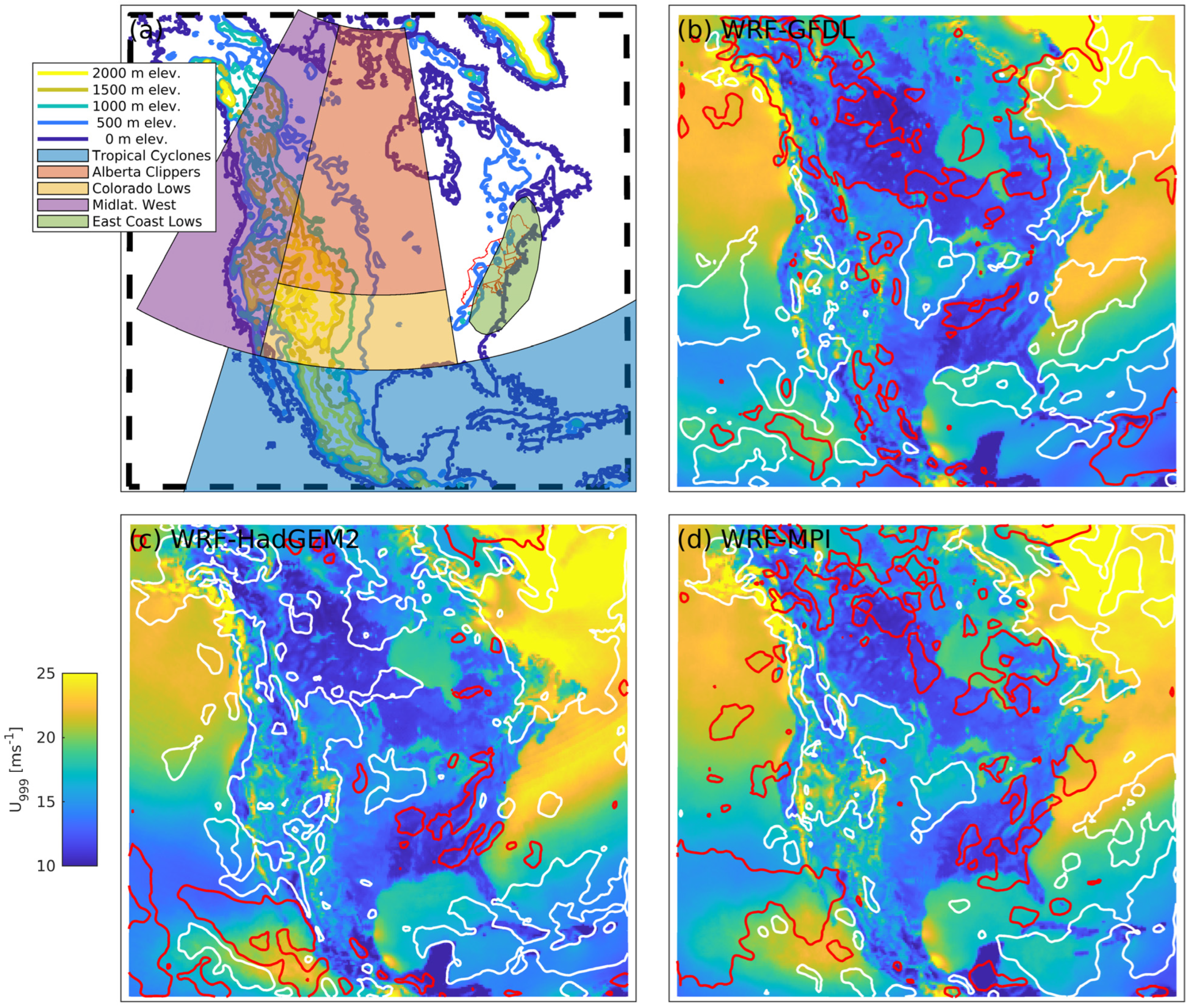
2. Materials and Methods
2.1. Study Region
2.2. NA-CORDEX Simulations
2.3. Windstorm Identification and Characterization
- Spatial scale: Fraction of NEland with simultaneous exceedance of U999 (referred to herein as U > U999Cov.) A related metric, termed windstorm size, is also computed. It is the total number of grid cells within a 1500 km radius of the sea-level pressure (SLP) minimum (cyclone centroid) with U > U999 at tp.
- Umax [ms−1]: Maximum wind speed in NEland grid cells during tp ± 12 h. The frequency of occurrence of windstorms with Umax > 22.5 ms−1 (strong gale according to the Beaufort scale [50]) is also reported.
- Loss index (LI): Highest U999 values from all simulations occur over water surfaces and in the complex terrain of western North America (Figure 1). However, socioeconomic damage from windstorms is a strong function of exposed assets. Thus, to provide an index of windstorm impact, we employ the LI concept that was first proposed based on data from Germany [51]. It has been widely used in quantifying windstorm socioeconomic consequences in the current and possible future climate [4,52,53]. The LI metric depends on the extent and magnitude of exceedance of locally defined wind speed thresholds, weighted by population as a proxy for assets exposed to wind damage [51]:
- Windstorm duration [hours]: Duration of time surrounding tp during which U > U999 continuously in >10% of NEland grid cells.
- Cyclone speed [km hr−1]: Translational velocity of the windstorm parent cyclone during the 12 h prior to tp.
2.4. Characterization of Cyclones Responsible for Windstorms
2.5. Tests for Statistical Significance
2.6. Evaluation of ERA-I Nested NA-CORDEX Simulations
3. Results
3.1. Evaluation of ERA-I Nested NA-CORDEX Simulation
3.2. Windstorm Characteristics in the Historical Period
3.3. Windstorm Projections
3.4. Cyclone Types Responsible for Windstorm
3.5. Diagnosing Causes of the Different Windstorm Projections
4. Discussion and Conclusions
- WRF-MPIa shows closest agreement with WRF-ERAI in terms of the representation of cyclone types responsible for windstorms in the NE and some windstorm characteristics. This realization of MPI also shows better agreement with ERA-Interim in terms of the representation of internal climate modes. This suggests that this model chain (WRF-MPI) has equal or better credibility than the other model chains. Conversely, simulations within lateral boundary conditions from GFDL indicate a smaller spatial scale of NE windstorms than those from WRF-ERAI. Analyses of output from WRF-GFDLa further indicate that much higher frequency of NE windstorms are associated with transitioning tropical cyclones leading to much higher values of accumulated kinetic energy within the windstorms and substantially smaller windstorm spatial scale.
- The spatial scale and frequency of the largest windstorms in each simulation defined using the greatest spatial extent of exceedance of local 99.9th percentile wind speeds (U > U999) plus long-period extreme wind speeds (U50,RP) do not exhibit secular trends. However, comparison of WRF-MPIb (future) simulation output and WRF-MPIa (historical) yields evidence for future increases in both the frequency of U > U999 over a substantial fraction of NEland and maximum wind speeds (Umax) > 22.5 ms−1. The future simulation within MPI also indicates a higher frequency of windstorms of all spatial extents than are present in the historical period. These projected changes in windstorm intensity and spatial scale lead to large magnitude increases in projected median loss indices (LIs) and hence inferred economic damage from future windstorms that are compounded by projected population increase. Statistically significant changes in projected windstorm intensity/scale are not found for WRF simulations within GFDL or HadGEM.
- Statistically significant monotonic trends are generally not evident in the cyclone types responsible for NE windstorms. However, consistent with previous analyses of independent WRF simulations nested within MPI [13], there is some evidence for an increasing role for transitioning tropical cyclones in the future based on the WRF-MPI simulation.
Author Contributions
Funding
Data Availability Statement
Conflicts of Interest
References
- Hirsch, M.E.; DeGaetano, A.T.; Colucci, S.J. An East Coast winter storm climatology. J. Clim. 2001, 14, 882–899. [Google Scholar] [CrossRef]
- Changnon, S.A. Temporal and spatial distributions of wind storm damages in the United States. Clim. Chang. 2009, 94, 473–482. [Google Scholar] [CrossRef]
- Lukens, K.E.; Berbery, E.H.; Hodges, K.I. The imprint of strong-storm tracks on winter weather in North America. J. Clim. 2018, 31, 2057–2074. [Google Scholar] [CrossRef]
- Letson, F.W.; Barthelmie, R.J.; Hodges, K.I.; Pryor, S.C. Intense windstorms in the northeastern United States. Nat. Hazards Earth Syst. Sci. 2021, 21, 2001–2020. [Google Scholar] [CrossRef]
- Hadavi, M.; Sun, L.; Romanic, D. Normalized insured losses caused by windstorms in Quebec and Ontario, Canada, in the period 2008–2021. Int. J. Disaster Risk Reduct. 2022, 80, 103222. [Google Scholar] [CrossRef]
- Little, A.S.; Priestley, M.D.; Catto, J.L. Future increased risk from extratropical windstorms in northern Europe. Nat. Commun. 2023, 14, 4434. [Google Scholar] [CrossRef] [PubMed]
- Laurila, T.K.; Gregow, H.; Cornér, J.; Sinclair, V.A. Characteristics of extratropical cyclones and precursors to windstorms in northern Europe. Weather Clim. Dyn. 2021, 2, 1111–1130. [Google Scholar] [CrossRef]
- Nilsson, C.; Goyette, S.; Barring, L. Relating forest damage data to the wind field from high-resolution RCM simulations: Case study of Anatol striking Sweden in December 1999. Glob. Planet. Chang. 2007, 57, 161–176. [Google Scholar] [CrossRef]
- Coburn, J.; Arnheim, J.; Pryor, S.C. Short-Term Forecasting of Wind Gusts at Airports Across CONUS Using Machine Learning. Earth Space Sci. 2022, 9, e2022EA002486. [Google Scholar] [CrossRef]
- Sparks, P.R. Wind speeds in tropical cyclones and associated insurance losses. J. Wind Eng. Ind. Aerodyn. 2003, 91, 1731–1751. [Google Scholar] [CrossRef]
- Chen, X.; Leung, L.R.; Gao, Y.; Liu, Y.; Wigmosta, M. Sharpening of cold-season storms over the western United States. Nat. Clim. Chang. 2023, 13, 167–173. [Google Scholar] [CrossRef]
- Seiler, C.; Zwiers, F.W. How will climate change affect explosive cyclones in the extratropics of the Northern Hemisphere? Clim. Dyn. 2016, 46, 3633–3644. [Google Scholar] [CrossRef]
- Zhou, X.; Barthelmie, R.J.; Letson, F.; Coburn, J.J.; Pryor, S.C. Extreme windstorms in the Northeastern USA in the contemporary and future climate. Clim. Dyn. 2024, 62, 2107–2128. [Google Scholar] [CrossRef]
- Coburn, J.J.; Barthelmie, R.J.; Pryor, S.C. Changing Windstorm Characteristics over the US Northeast in a Single Model Large Ensemble. Environ. Res. Lett. 2024, 19, 114045. [Google Scholar] [CrossRef]
- Raible, C.C.; Pinto, J.G.; Ludwig, P.; Messmer, M. A review of past changes in extratropical cyclones in the northern hemisphere and what can be learned for the future. Wiley Interdiscip. Rev. Clim. Chang. 2021, 12, e680. [Google Scholar] [CrossRef]
- Studholme, J.; Fedorov, A.V.; Gulev, S.K.; Emanuel, K.; Hodges, K. Poleward expansion of tropical cyclone latitudes in warming climates. Nat. Geosci. 2022, 15, 14–28. [Google Scholar] [CrossRef]
- Varino, F.; Arbogast, P.; Joly, B.; Riviere, G.; Fandeur, M.-L.; Bovy, H.; Granier, J.-B. Northern Hemisphere extratropical winter cyclones variability over the 20th century derived from ERA-20C reanalysis. Clim. Dyn. 2019, 52, 1027–1048. [Google Scholar] [CrossRef]
- Vose, R.S.; Applequist, S.; Bourassa, M.A.; Pryor, S.C.; Barthelmie, R.J.; Blanton, B.; Bromirski, P.D.; Brooks, H.E.; DeGaetano, A.T.; Dole, R.M. Monitoring and understanding changes in extremes: Extratropical storms, winds, and waves. Bull. Am. Meteorol. Soc. 2014, 95, 377–386. [Google Scholar] [CrossRef]
- Colle, B.A.; Booth, J.F.; Chang, E.K. A review of historical and future changes of extratropical cyclones and associated impacts along the US East Coast. Curr. Clim. Chang. Rep. 2015, 1, 125–143. [Google Scholar] [CrossRef]
- Chang, E.K.; Guo, Y.; Xia, X. CMIP5 multimodel ensemble projection of storm track change under global warming. J. Geophys. Res. Atmos. 2012, 117, D23118. [Google Scholar] [CrossRef]
- Harvey, B.; Shaffrey, L.; Woollings, T. Equator-to-pole temperature differences and the extra-tropical storm track responses of the CMIP5 climate models. Clim. Dyn. 2014, 43, 1171–1182. [Google Scholar] [CrossRef]
- Sheffield, J.; Barrett, A.P.; Colle, B.; Nelun Fernando, D.; Fu, R.; Geil, K.L.; Hu, Q.; Kinter, J.; Kumar, S.; Langenbrunner, B. North American climate in CMIP5 experiments. Part I: Evaluation of historical simulations of continental and regional climatology. J. Clim. 2013, 26, 9209–9245. [Google Scholar] [CrossRef]
- Sainsbury, E.M.; Schiemann, R.K.; Hodges, K.I.; Shaffrey, L.C.; Baker, A.J.; Bhatia, K.T. How Important are Post-Tropical Cyclones for European Windstorm Risk? Geophys. Res. Lett. 2020, 47, e2020GL089853. [Google Scholar] [CrossRef]
- Garner, A.J.; Kopp, R.E.; Horton, B.P. Evolving tropical cyclone tracks in the North Atlantic in a warming climate. Earth’s Future 2021, 9, e2021EF002326. [Google Scholar] [CrossRef]
- Colbert, A.J.; Soden, B.J.; Vecchi, G.A.; Kirtman, B.P. The impact of anthropogenic climate change on North Atlantic tropical cyclone tracks. J. Clim. 2013, 26, 4088–4095. [Google Scholar] [CrossRef]
- Shu, E.G.; Pope, M.; Wilson, B.; Bauer, M.; Amodeo, M.; Freeman, N.; Porter, J.R. Assessing Property Exposure to Cyclonic Winds under Climate Change. Climate 2023, 11, 217. [Google Scholar] [CrossRef]
- Pryor, S.C.; Barthelmie, R.J.; Schoof, J.T. Past and future wind climates over the contiguous USA based on the NARCCAP model suite. J. Geophys. Res. 2012, 117. [Google Scholar] [CrossRef]
- Giorgi, F.; Gutowski, W.J., Jr. Regional dynamical downscaling and the CORDEX initiative. Annu. Rev. Environ. Resour. 2015, 40, 467–490. [Google Scholar] [CrossRef]
- Gutowski, W.J., Jr.; Giorgi, F.; Timbal, B.; Frigon, A.; Jacob, D.; Kang, H.S.; Raghavan, K.; Lee, B.; Lennard, C.; Nikulin, G.; et al. WCRP COordinated Regional Downscaling EXperiment (CORDEX): A diagnostic MIP for CMIP6. Geosci. Model Dev. 2016, 9, 4087–4095. [Google Scholar] [CrossRef]
- Sørland, S.L.; Brogli, R.; Pothapakula, P.K.; Russo, E.; Van de Walle, J.; Ahrens, B.; Anders, I.; Bucchignani, E.; Davin, E.L.; Demory, M.-E. COSMO-CLM regional climate simulations in the Coordinated Regional Climate Downscaling Experiment (CORDEX) framework: A review. Geosci. Model Dev. 2021, 14, 5125–5154. [Google Scholar] [CrossRef]
- Prein, A.F.; Bukovsky, M.S.; Mearns, L.O.; Bruyère, C.L.; Done, J.M. Simulating North American weather types with regional climate models. Front. Environ. Sci. 2019, 7, 36. [Google Scholar] [CrossRef]
- Diez-Sierra, J.; Iturbide, M.; Gutiérrez, J.M.; Fernández, J.; Milovac, J.; Cofiño, A.S.; Cimadevilla, E.; Nikulin, G.; Levavasseur, G.; Kjellström, E. The worldwide C3S CORDEX grand ensemble: A major contribution to assess regional climate change in the IPCC AR6 Atlas. Bull. Am. Meteorol. Soc. 2022, 103, E2804–E2826. [Google Scholar] [CrossRef]
- Reidmiller, D.R. Impacts, Risks, and Adaptation in the United States: Fourth National Climate Assessment; USGCRP: Washington, DC, USA, 2018; Volume II.
- Hodges, K.I.; Lee, R.W.; Bengtsson, L. A Comparison of Extratropical Cyclones in Recent Reanalyses ERA-Interim, NASA MERRA, NCEP CFSR, and JRA-25. J. Clim. 2011, 24, 4888–4906. [Google Scholar] [CrossRef]
- Pryor, S.C.; Barthelmie, R.J. A global assessment of extreme wind speeds for wind energy applications. Nat. Energy 2021, 6, 268–276. [Google Scholar] [CrossRef]
- Simmons, A.; Uppala, S.; Dee, D.; Kobayashi, S. ERA-Interim: New ECMWF reanalysis products from 1989 onwards. ECMWF Newsl. 2007, 110, 25–35. [Google Scholar]
- Dunne, J.P.; John, J.G.; Adcroft, A.J.; Griffies, S.M.; Hallberg, R.W.; Shevliakova, E.; Stouffer, R.J.; Cooke, W.; Dunne, K.A.; Harrison, M.J. GFDL’s ESM2 global coupled climate–carbon earth system models. Part I: Physical formulation and baseline simulation characteristics. J. Clim. 2012, 25, 6646–6665. [Google Scholar] [CrossRef]
- Jones, C.; Hughes, J.; Bellouin, N.; Hardiman, S.; Jones, G.; Knight, J.; Liddicoat, S.; O’connor, F.; Andres, R.J.; Bell, C. The HadGEM2-ES implementation of CMIP5 centennial simulations. Geosci. Model Dev. 2011, 4, 543–570. [Google Scholar] [CrossRef]
- Giorgetta, M.A.; Jungclaus, J.; Reick, C.H.; Legutke, S.; Bader, J.; Böttinger, M.; Brovkin, V.; Crueger, T.; Esch, M.; Fieg, K. Climate and carbon cycle changes from 1850 to 2100 in MPI-ESM simulations for the Coupled Model Intercomparison Project phase 5. J. Adv. Model. Earth Syst. 2013, 5, 572–597. [Google Scholar] [CrossRef]
- Flato, G.; Marotzke, J.; Abiodun, B.; Braconnot, P.; Chou, S.C.; Collins, W.; Cox, P.; Driouech, F.; Emori, S.; Eyring, V. Evaluation of climate models. In Climate Change 2013: The Physical Science Basis. Contribution of Working Group I to the Fifth Assessment Report of the Intergovernmental Panel on Climate Change; Cambridge University Press: Cambridge, UK, 2014; pp. 741–866. [Google Scholar]
- Brunner, L.; Pendergrass, A.G.; Lehner, F.; Merrifield, A.L.; Lorenz, R.; Knutti, R. Reduced global warming from CMIP6 projections when weighting models by performance and independence. Earth Syst. Dyn. 2020, 11, 995–1012. [Google Scholar] [CrossRef]
- Eyring, V.; Cox, P.M.; Flato, G.M.; Gleckler, P.J.; Abramowitz, G.; Caldwell, P.; Collins, W.D.; Gier, B.K.; Hall, A.D.; Hoffman, F.M. Taking climate model evaluation to the next level. Nat. Clim. Chang. 2019, 9, 102–110. [Google Scholar] [CrossRef]
- Bukovsky, M.S.; Mearns, L.O. Regional climate change projections from NA-CORDEX and their relation to climate sensitivity. Clim. Change 2020, 162, 645–665. [Google Scholar] [CrossRef]
- Dong, Y.; Armour, K.C.; Zelinka, M.D.; Proistosescu, C.; Battisti, D.S.; Zhou, C.; Andrews, T. Intermodel spread in the pattern effect and its contribution to climate sensitivity in CMIP5 and CMIP6 models. J. Clim. 2020, 33, 7755–7775. [Google Scholar] [CrossRef]
- Colle, B.A.; Zhang, Z.; Lombardo, K.A.; Chang, E.; Liu, P.; Zhang, M. Historical evaluation and future prediction of eastern North American and western Atlantic extratropical cyclones in the CMIP5 models during the cool season. J. Clim. 2013, 26, 6882–6903. [Google Scholar] [CrossRef]
- Collier, C.; Dixon, J.; Harrison, M.; Hunt, J.; Mitchell, J.; Richardson, D. Extreme surface winds in mid-latitude storms: Forecasting and changes in climatology. J. Wind Eng. Ind. Aerodyn. 1994, 52, 1–27. [Google Scholar] [CrossRef]
- Smart, D.; Browning, K. Attribution of strong winds to a cold conveyor belt and sting jet. Q. J. R. Meteorol. Soc. 2014, 140, 595–610. [Google Scholar] [CrossRef]
- Trzeciak, T.M.; Knippertz, P.; Pirret, J.S.R.; Williams, K.D. Can we trust climate models to realistically represent severe European windstorms? Clim. Dyn. 2016, 46, 3431–3451. [Google Scholar] [CrossRef][Green Version]
- Donat, M.; Leckebusch, G.; Wild, S.; Ulbrich, U. Future changes in European winter storm losses and extreme wind speeds inferred from GCM and RCM multi-model simulations. Nat. Hazards Earth Syst. Sci. 2011, 11, 1351–1370. [Google Scholar] [CrossRef]
- Forrester, F.H. How strong is the wind? The origin of the Beaufort Scale. Weatherwise 1986, 39, 147–151. [Google Scholar] [CrossRef]
- Klawa, M.; Ulbrich, U. A model for the estimation of storm losses and the identification of severe winter storms in Germany. Nat. Hazards Earth Syst. Sci. 2003, 3, 725–732. [Google Scholar] [CrossRef]
- Pinto, J.G.; Karremann, M.K.; Born, K.; Della-Marta, P.M.; Klawa, M. Loss potentials associated with European windstorms under future climate conditions. Clim. Res. 2012, 54, 1–20. [Google Scholar] [CrossRef]
- Priestley, M.D.; Dacre, H.F.; Shaffrey, L.C.; Hodges, K.I.; Pinto, J.G. The role of serial European windstorm clustering for extreme seasonal losses as determined from multi-centennial simulations of high-resolution global climate model data. Nat. Hazards Earth Syst. Sci. 2018, 18, 2991–3006. [Google Scholar] [CrossRef]
- Moemken, J.; Messori, G.; Pinto, J.G. Windstorm losses in Europe–What to gain from damage datasets. Weather Clim. Extrem. 2024, 44, 100661. [Google Scholar] [CrossRef]
- Moemken, J.; Alifdini, I.; Ramos, A.M.; Georgiadis, A.; Brocklehurst, A.; Braun, L.; Pinto, J.G. Insurance loss model vs meteorological loss index–How comparable are their loss estimates for European windstorms? Nat. Hazards Earth Syst. Sci. Discuss. 2024, 2024, 1–19. [Google Scholar] [CrossRef]
- Aznar-Siguan, G.; Bresch, D.N. CLIMADA v1: A global weather and climate risk assessment platform. Geosci. Model Dev. 2019, 12, 3085–3097. [Google Scholar] [CrossRef]
- Gao, J.; Pesaresi, M. Downscaling SSP-consistent global spatial urban land projections from 1/8-degree to 1-km resolution 2000–2100. Sci. Data 2021, 8, 281. [Google Scholar] [CrossRef]
- Wilks, D.S. Statistical Methods in the Atmospheric Sciences, 4th ed.; Elsevier: Amsterdam, The Netherlands, 2020; p. 840. [Google Scholar]
- Mailier, P.J.; Stephenson, D.B.; Ferro, C.A.; Hodges, K.I. Serial clustering of extratropical cyclones. Mon. Weather Rev. 2006, 134, 2224–2240. [Google Scholar] [CrossRef]
- Vitolo, R.; Stephenson, D.B.; Cook, I.M.; Mitchell-Wallace, K. Serial clustering of intense European storms. Meteorol. Z. 2009, 18, 411–424. [Google Scholar] [CrossRef]
- Palutikof, J.P.; Brabson, B.B.; Lister, D.H.; Adcock, S.T. A review of methods to calculate extreme wind speeds. Meteorol. Appl. 1999, 6, 119–132. [Google Scholar] [CrossRef]
- Maue, R.N. Recent historically low global tropical cyclone activity. Geophys. Res. Lett. 2011, 38. [Google Scholar] [CrossRef]
- Hoskins, B.J.; Hodges, K.I. New perspectives on the Northern Hemisphere winter storm tracks. J. Atmos. Sci. 2002, 59, 1041–1061. [Google Scholar] [CrossRef]
- Fritzen, R.; Lang, V.; Gensini, V.A. Trends and variability of North American cool-season extratropical cyclones: 1979–2019. J. Appl. Meteorol. Climatol. 2021, 60, 1319–1331. [Google Scholar] [CrossRef]
- Klotzbach, P.J.; Oliver, E.C.; Leeper, R.D.; Schreck, C.J. The relationship between the Madden–Julian oscillation (MJO) and southeastern New England snowfall. Mon. Weather Rev. 2016, 144, 1355–1362. [Google Scholar] [CrossRef]
- Cook, N.J. Locating the anemometers of the US ASOS network and classifying their local shelter. Weather 2022, 77, 256–263. [Google Scholar] [CrossRef]
- McNitt, J.A.; Facundo, J. An overview of the Federal Government’s Automated Surface Observing System sustainment activity. In Proceedings of the 13th American Meteorological Society Conference on Integrated Observing and Assimilation Systems for Atmosphere, Oceans, and Land Surface, Pheonix, AZ, USA, 10–11 January 2009. [Google Scholar]
- Cook, N.J. Curating the TD6405 database of 1-min interval wind observations across the USA for use in Wind Engineering studies. J. Wind Eng. Ind. Aerodyn. 2022, 224, 104961. [Google Scholar] [CrossRef]
- Schmitt, I.V.; Chester, V. A quality control algorithm for the ASOS ice free wind sensor. In Proceedings of the 13th American Meteorological Society Conference on Integrated Observing and Assimilation Systems for Atmosphere, Oceans, and Land Surface, Pheonix, AZ, USA, 10–11 January 2009. [Google Scholar]
- Landsea, C.W.; Franklin, J.L. Atlantic hurricane database uncertainty and presentation of a new database format. Mon. Weather Rev. 2013, 141, 3576–3592. [Google Scholar] [CrossRef]
- Woods, M.J.; Davy, R.J.; Russell, C.J.; Coppin, P.A. Cross-spectrum of wind speed for meso-gamma scales in the upper surface layer over South-Eastern Australia. Bound.-Layer Meteorol. 2011, 141, 93–116. [Google Scholar] [CrossRef]
- Herrmann, M.; Somot, S.; Calmanti, S.; Dubois, C.; Sevault, F. Representation of spatial and temporal variability of daily wind speed and of intense wind events over the Mediterranean Sea using dynamical downscaling: Impact of the regional climate model configuration. Nat. Hazards Earth Syst. Sci. 2011, 11, 1983–2001. [Google Scholar] [CrossRef]
- Pryor, S.C.; Coburn, J.; Barthelmie, R.; Shepherd, T. Projecting Future Energy Production from Operating Wind Farms in North America: Part 1: Dynamical Downscaling. J. Appl. Meteorol. Climatol. 2022, 62, 1558–8424. [Google Scholar] [CrossRef]
- National Oceanic and Atmospheric Administration. Hurricane Charley, August 9–15, 2004; Department of Commerce, National Atmospheric and Oceanic Administration: Silver Spring, MD, USA, 2004; p. 29. Available online: https://www.weather.gov/media/publications/assessments/Charley06.pdf (accessed on 11 May 2025).
- Condon, A.J.; Sheng, Y.P.; Paramygin, V.A. Toward high-resolution, rapid, probabilistic forecasting of the inundation threat from landfalling hurricanes. Mon. Weather Rev. 2013, 141, 1304–1323. [Google Scholar] [CrossRef]
- Rendfrey, T.S.; Bukovsky, M.S.; McCrary, R.R.; Fuentes-Franco, R. An assessment of tropical cyclones in North American CORDEX WRF simulations. Weather Clim. Extrem. 2021, 34, 100382. [Google Scholar] [CrossRef]
- Chen, T.C.; Di Luca, A.; Winger, K.; Laprise, R.; Thériault, J.M. Seasonality of continental extratropical-cyclone wind speeds over northeastern North America. Geophys. Res. Lett. 2022, 49, e2022GL098776. [Google Scholar] [CrossRef]
- Pryor, S.C.; Barthelmie, R.J.; Bukovsky, M.S.; Leung, L.R.; Sakaguchi, K. Climate change impacts on wind power generation. Nat. Rev. Earth Environ. 2020, 1, 627–643. [Google Scholar] [CrossRef]
- Schoof, J.T.; Pryor, S.C. Assessing the fidelity of AOGCM-simulated relationships between large-scale modes of climate variability and wind speeds. J. Geophys. Res. 2014, 119, 9719–9734. [Google Scholar] [CrossRef]
- Sun, Y.; Zhong, Z.; Li, T.; Yi, L.; Shen, Y. The slowdown tends to be greater for stronger tropical cyclones. J. Clim. 2021, 34, 5741–5751. [Google Scholar] [CrossRef]
- McCloskey, T.A.; Bianchette, T.A.; Liu, K.-B. Track patterns of landfalling and coastal tropical cyclones in the Atlantic basin, their relationship with the North Atlantic oscillation (NAO), and the potential effect of global warming. Am. J. Clim. Chang. 2013, 2, 11. [Google Scholar] [CrossRef]
- Coburn, J.; Pryor, S.C. Evolution of the Internal Climate Modes under Future Warming. J. Clim. 2023, 36, 511–529. [Google Scholar] [CrossRef]
- Jeong, D.I.; Sushama, L. Projected changes to mean and extreme surface wind speeds for North America based on regional climate model simulations. Atmosphere 2019, 10, 497. [Google Scholar] [CrossRef]
- Roberts, M.J.; Camp, J.; Seddon, J.; Vidale, P.L.; Hodges, K.; Vannière, B.; Mecking, J.; Haarsma, R.; Bellucci, A.; Scoccimarro, E. Projected future changes in tropical cyclones using the CMIP6 HighResMIP multimodel ensemble. Geophys. Res. Lett. 2020, 47, e2020GL088662. [Google Scholar] [CrossRef]
- Priestley, M.D.; Ackerley, D.; Catto, J.L.; Hodges, K.I.; McDonald, R.E.; Lee, R.W. An overview of the extratropical storm tracks in CMIP6 historical simulations. J. Clim. 2020, 33, 6315–6343. [Google Scholar] [CrossRef]
- Martínez-Alvarado, O.; Gray, S.L.; Hart, N.C.; Clark, P.A.; Hodges, K.; Roberts, M.J. Increased wind risk from sting-jet windstorms with climate change. Environ. Res. Lett. 2018, 13, 044002. [Google Scholar] [CrossRef]
- Pryor, S.C.; Nikulin, G.; Jones, C. Influence of spatial resolution on Regional Climate Model derived wind climates. J. Geophys. Res. 2012, 117. [Google Scholar] [CrossRef]
- Jung, C.; Schindler, D. Does the winter storm-related wind gust intensity in Germany increase under warming climate?—A high-resolution assessment. Weather Clim. Extrem. 2021, 33, 100360. [Google Scholar] [CrossRef]
- Pryor, S.C.; Schoof, J.T. Importance of the SRES in projections of climate change impacts on near-surface wind regimes. Meteorol. Z. 2010, 19, 267–274. [Google Scholar]
- Mearns, L.O.; McGinnis, S.; Korytina, D.; Arritt, R.; Biner, S.; Bukovsky, M.; Chang, H.-I.; Christensen, O.; Herzmann, D.; Jiao, Y.; et al. The NA-CORDEX Dataset; Version 1.0; NCAR Climate Data Gateway: Boulder, CO, USA, 2017. [Google Scholar] [CrossRef]

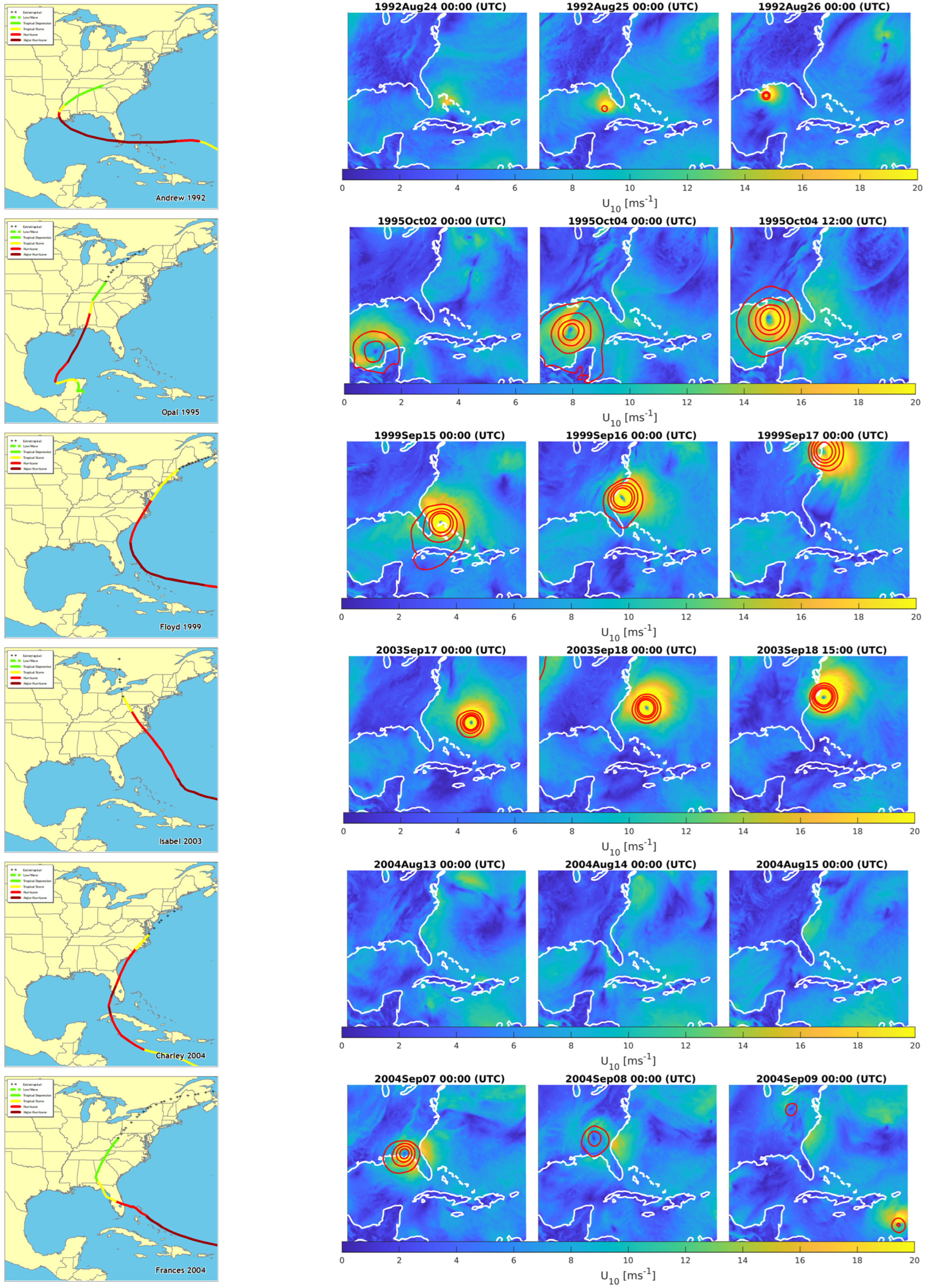
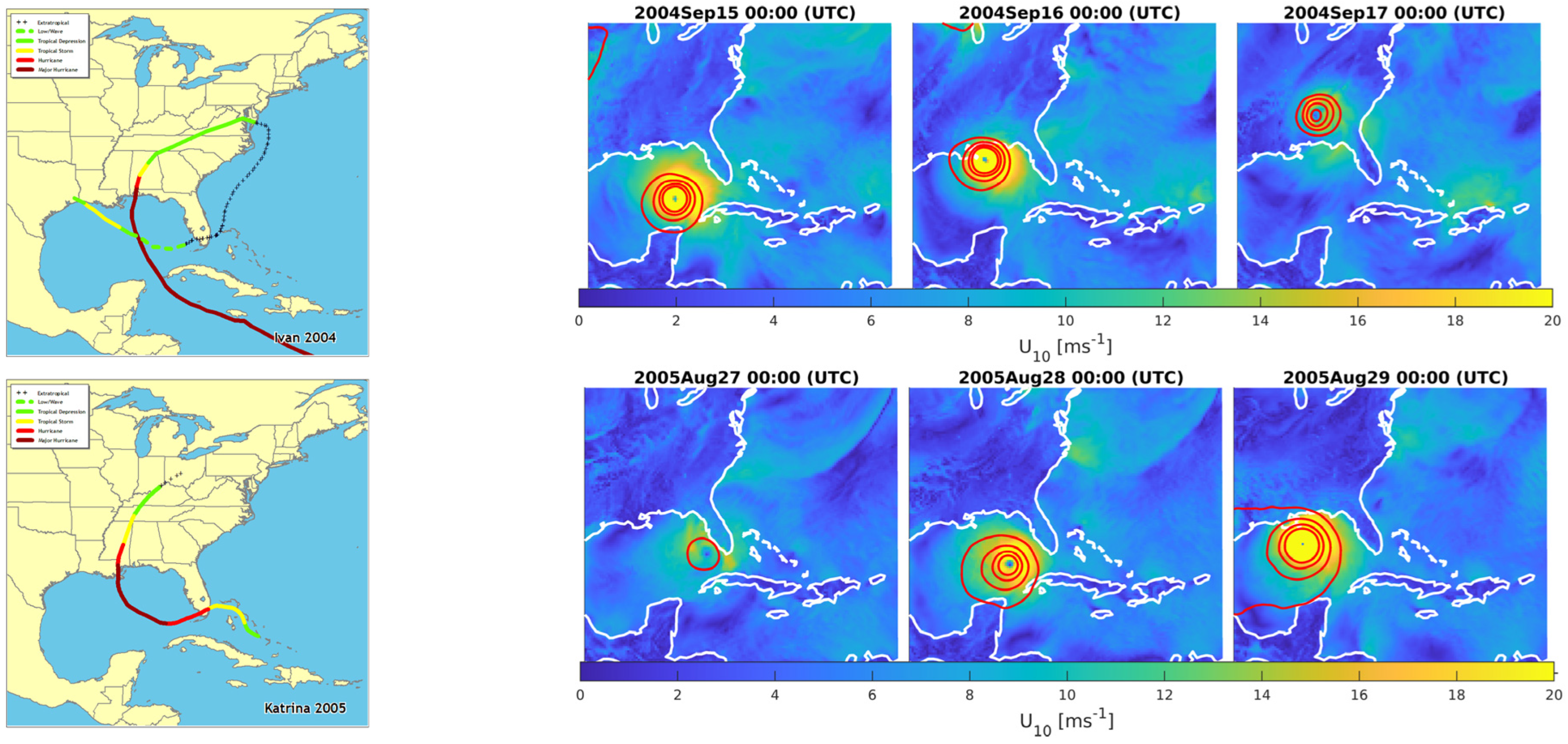
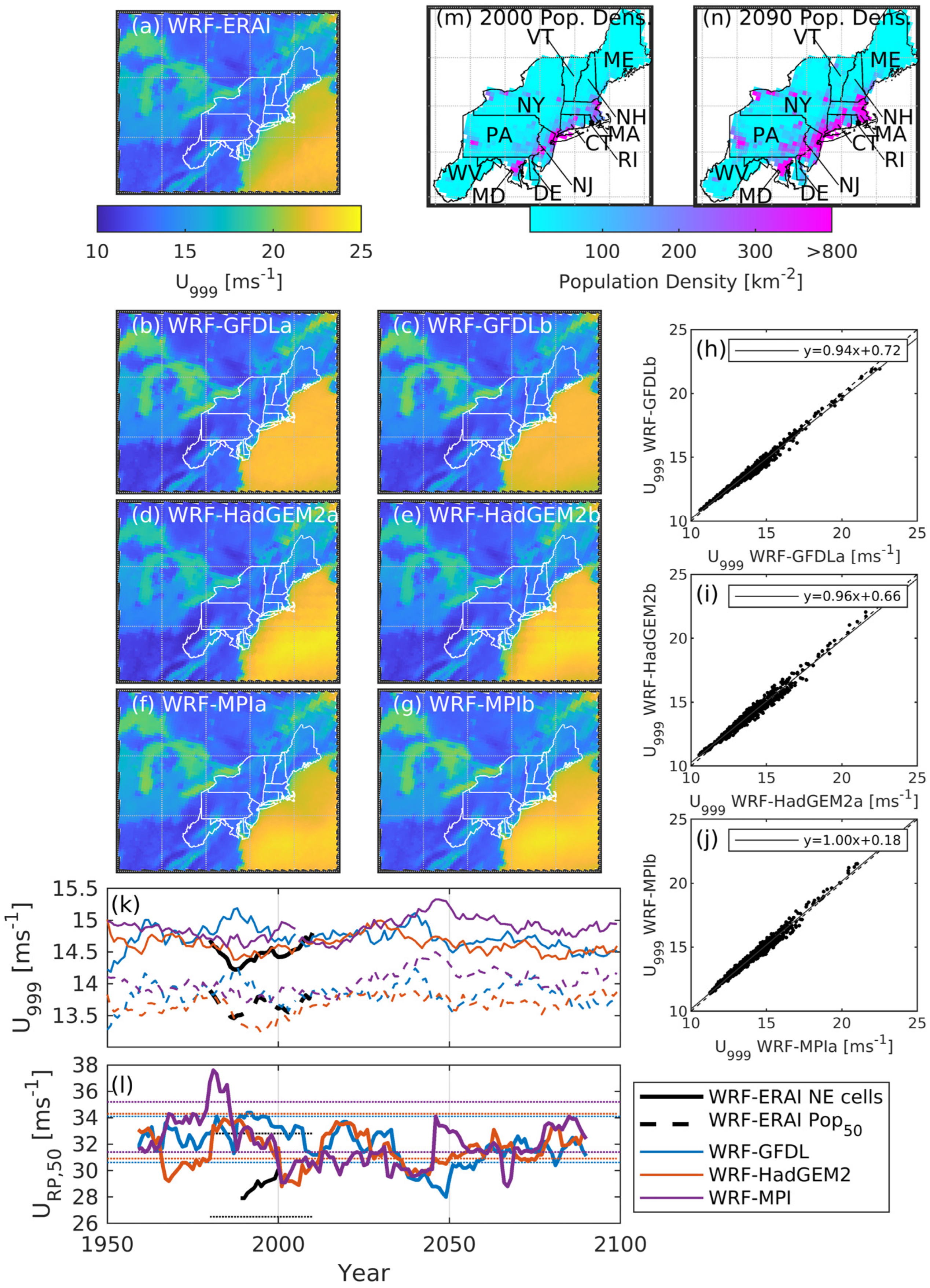
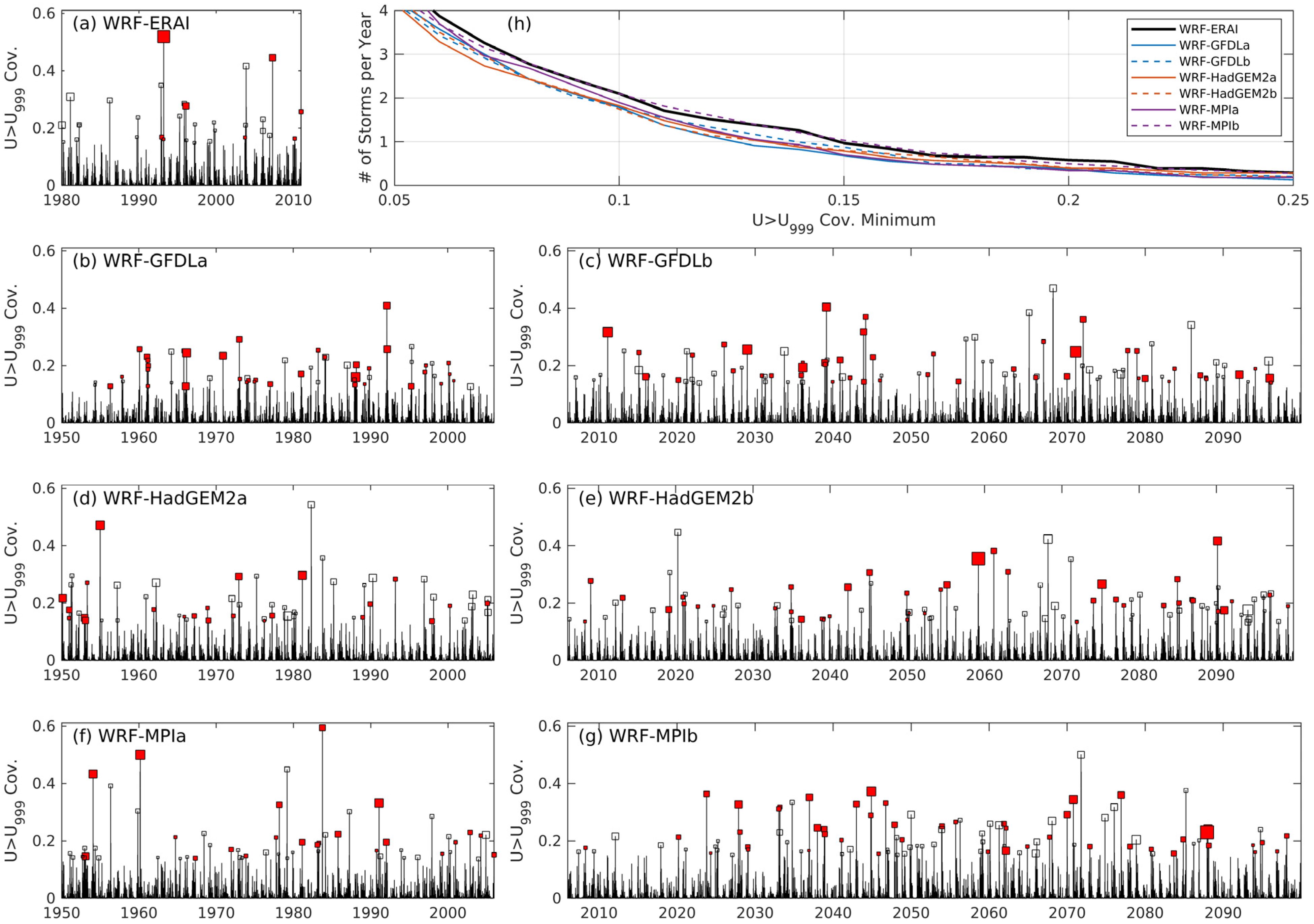


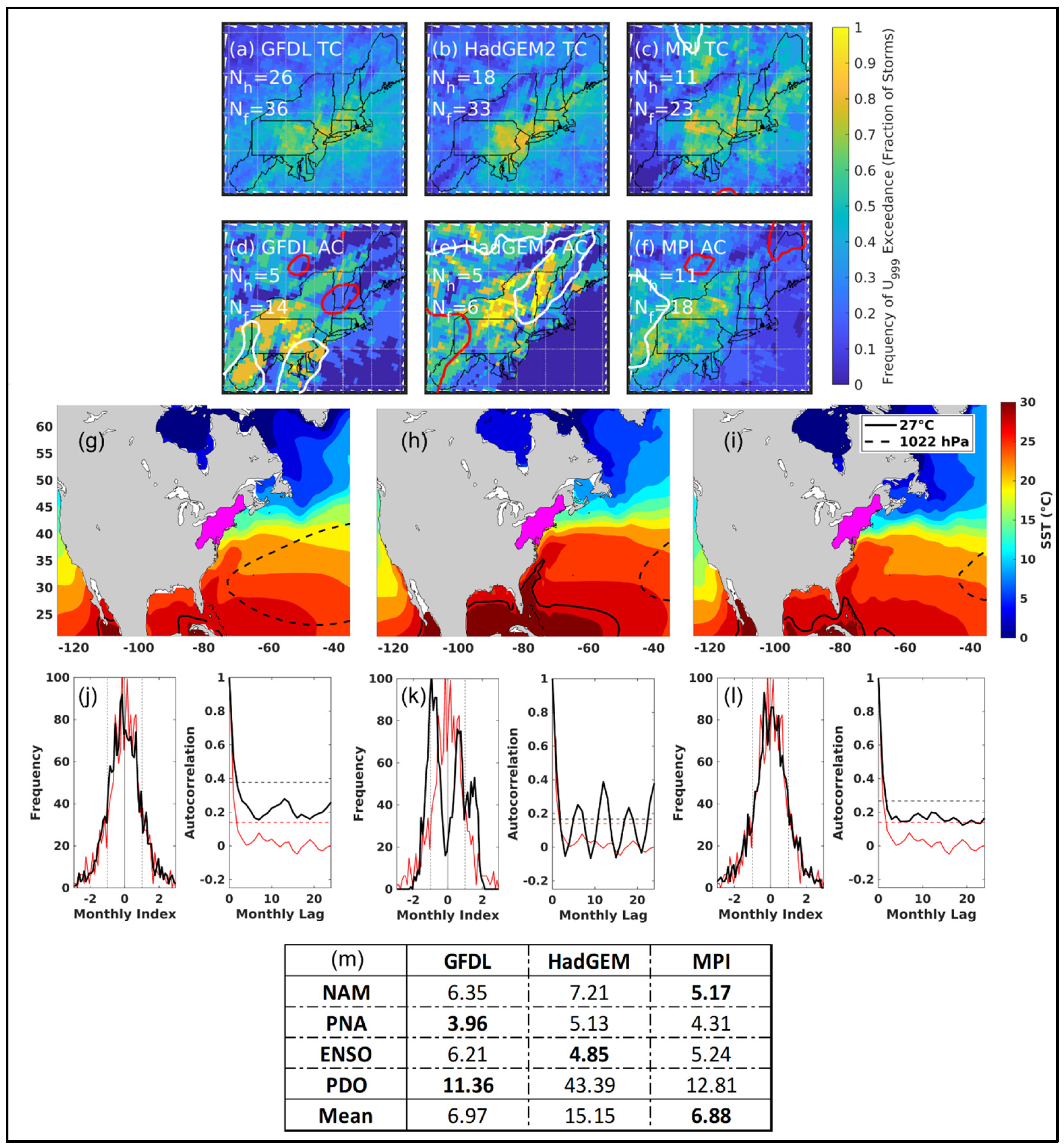
| Description | Abbreviation | WRF-ERAI | WRF-GFDLa | WRF-GFDLb | WRF-HadGEMa | WRF-HadGEMb | WRF-MPIa | WRF-MPIb |
|---|---|---|---|---|---|---|---|---|
| Transitioning Tropical Cyclones | TC | 16 | 46 | 38 | 32 | 35 | 19 | 24 |
| Alberta Clippers | AC | 16 | 8 | 14 | 8 | 6 | 19 | 19 |
| Colorado Lows | CL | 35 | 14 | 18 | 21 | 18 | 10 | 21 |
| Midlatitude West | MW | 6 | 8 | 5 | 8 | 8 | 12 | 8 |
| East Coast Lows | EC | 16 | 10 | 9 | 8 | 9 | 19 | 13 |
| Other | Other | 9 | 10 | 13 | 19 | 22 | 17 | 12 |
Disclaimer/Publisher’s Note: The statements, opinions and data contained in all publications are solely those of the individual author(s) and contributor(s) and not of MDPI and/or the editor(s). MDPI and/or the editor(s) disclaim responsibility for any injury to people or property resulting from any ideas, methods, instructions or products referred to in the content. |
© 2025 by the authors. Licensee MDPI, Basel, Switzerland. This article is an open access article distributed under the terms and conditions of the Creative Commons Attribution (CC BY) license (https://creativecommons.org/licenses/by/4.0/).
Share and Cite
Pryor, S.C.; Coburn, J.J.; Letson, F.W.; Zhou, X.; Bukovsky, M.S.; Barthelmie, R.J. Historical and Future Windstorms in the Northeastern United States. Climate 2025, 13, 105. https://doi.org/10.3390/cli13050105
Pryor SC, Coburn JJ, Letson FW, Zhou X, Bukovsky MS, Barthelmie RJ. Historical and Future Windstorms in the Northeastern United States. Climate. 2025; 13(5):105. https://doi.org/10.3390/cli13050105
Chicago/Turabian StylePryor, Sara C., Jacob J. Coburn, Fred W. Letson, Xin Zhou, Melissa S. Bukovsky, and Rebecca J. Barthelmie. 2025. "Historical and Future Windstorms in the Northeastern United States" Climate 13, no. 5: 105. https://doi.org/10.3390/cli13050105
APA StylePryor, S. C., Coburn, J. J., Letson, F. W., Zhou, X., Bukovsky, M. S., & Barthelmie, R. J. (2025). Historical and Future Windstorms in the Northeastern United States. Climate, 13(5), 105. https://doi.org/10.3390/cli13050105








